L’Absolut Vodka ha una storia davvero interessante. Esportata dal 1979, divenne in poco tempo uno dei più prestigiosi e venduti marchi di vodka al mondo. Si tratta, è vero, di un prodotto eccellente, ma parte del suo successo deriva anche dall’uso di sapienti strategie di marketing che includono anche la scelta di un packaging molto speciale.
Ripercorriamo qui per voi le tappe principali.
La vodka era prodotta in Svezia sin dal 15esimo secolo. Era un distillato chiamato “bränvin”, letteralmente “burnt wine” (vino bruciato). Questi liquori, prodotti da cereali o da vino di importazione, erano originariamente usati come medicinali o per produrre polvere da sparo.
Ma gli svedesi scoprirono presto che l’alcool può avere anche una funzione “ricreativa”. Così, nel 17esimo secolo, il distillato che oggi noi chiamiamo vodka divenne la bevanda nazionale.
Il successo del prodotto è noto a tutti. Quello che forse non tutti conoscono sono i successi dell’uomo che l’ha introdotta. Imprenditore a dir poco precoce, all’età di 14 anni Lars Olsson Smith forse stava ancora imparando a farsi la barba, ma controllava già un terzo della vodka prodotta in Svezia. Nel 1879, introdusse un rivoluzionario metodo di distillazione, usato ancora oggi, per produrre la “Absolut Rent Bränvin” (Absolute Pure Vodka). Cominciò, senza saperlo, a distribuire quella che un secolo dopo divenne esattamente la Absolut Vodka.
Olssen, non solo creò un buon prodotto migliorandone il gusto, ma iniziò una vera e propria guerra contro la città di Stoccolma che deteneva il monopolio dell’alcool. Rifiutandosi di pagare per avere la licenza di vendere il suo prodotto in città, aprì un uno store accanto alla sua distilleria,sull’isola di Reimersholme. I clienti erano accompagnati dal centro città al negozio con un piccolo battello messo a disposizione gratuitamente, una incredibile iniziativa di marketing per il periodo!
Il negozio ebbe un enorme successo, la guerra con Stoccolma continuò e Smith cominciò a espandere il suo business nelle regioni meridionali della Svezia, luogo da secoli famoso per la produzione di vodka, acquistando diverse distillerie e canali di distribuzione. Intorno alla fine del secolo, iniziò a esportare con successo diventando uno degli uomini più ricchi del paese. Una fortuna che con alterne vicende perse, riguadagnò e poi perse ancora. Morì nel 1913, senza un soldo, ma pieno di debiti e sommerso da beghe legali.
Ma le competenze tecniche e il fiuto per gli affari non morirono con lui. Nel 1970 il suo successore, Lars Lindmark, ex presidente della Swedish Wine and Spirits Corporation, pensò subito di dare un tocco di modernità alla vecchia azienda. Con l’avvicinarsi del centesimo anniversario della Absolut Rent Bränvin, la decisione strategica del nuovo management era proporre la storica “Absolut Vodka” al mercato statunitense.
Era quindi necessario ripensare il prodotto. La svolta venne con la scelta del packaging e, come tutte le svolte, avvenne per caso, in modo abbastanza banale.
Fu il pubblicitario Gunnar Broman a offrire lo spunto. A spasso per le strade della vecchia Stoccolma, Broman scoprì tra le vetrine di un antiquario un’antica BOTTIGLIA per medicinali, un oggetto la cui forma iconica era rimasta immutata per centinaia di anni. Nel ‘500 e nel ‘600 infatti la vodka era venduta in farmacia per curare tutto, dalle coliche alle piaghe.
Il contenitore era elegante, semplice, differente ma molto svedese, e catturò subito l’attenzione dei pubblicitari. Dopo diversi tentativi, il team di designer incaricato di sviluppare la bottiglia optò per un prodotto che nascondesse il meno possibile il liquido cristallino al suo interno. Fu inserita solo una piccola etichetta dal lettering di colore blu, ancora oggi usato per il logo di Absolut Vodka.
Prodotto e confezione erano pronti, ora serviva un nome. Nell’originale inglese “Absolute Pure Vodka” la parola Absolute divenne “Absolut” per aggirare problemi di diritto d’autore e la parola “pure” fu eliminata per questioni legali. Fu aggiunto tra gli elementi restanti lo slogan “Country of Sweden” per sottolinearne le origini e la purezza.
Il primo carico di Absolut Vodka fu preparato nelle distillerie di Åhus (Sweden) il 17 aprile 1979 e la vodka iniziò a essere venduta due mesi più tardi prima a Boston, in seguito a New York, Chicago, Los Angeles, San Francisco e quindi in tutto il paese. Nel 1985 le vendite di Absolut Vodka sorpassarono quelle del più grande competitor russo diventando la più venduta negli USA. Dopo il successo negli Stati Uniti il prodotto iniziò a essere esportato a partire dalla metà degli anni ’80 nella maggior parte dei paesi europei e asiatici. Dal 1994, rientra tra i più prestigiosi marchi di alcolici al mondo.
Absolut Vodka has a really interesting history. Exported since 1979, it quickly became one of the most prestigious and best-selling vodka brands in the world. It is true that it is an excellent product, but part of its success also derives from the use of wise marketing strategies that also include the choice of a very special packaging.
Here we retrace the main stages for you.
Vodka has been produced in Sweden since the 15th century. It was a distillate called “bränvin”, literally “burnt wine”. These liqueurs, made from imported grains or wine, were originally used as medicines or to make gunpowder.
But the Swedes soon discovered that alcohol can also have a “recreational” function. Thus, in the 17th century, the spirit that we now call vodka became the national drink.
The success of the product is known to all. What perhaps not everyone knows are the successes of the man who introduced it. An early entrepreneur, to say the least, at the age of 14 Lars Olsson Smith was perhaps still learning to shave, but he already controlled a third of the vodka produced in Sweden. In 1879, he introduced a revolutionary distillation method, still used today, to produce “Absolut Rent Bränvin” (Absolute Pure Vodka). He began, without knowing it, to distribute what a century later exactly became Absolut Vodka.
Olssen, not only created a good product by improving its taste, but started a real war against the city of Stockholm which held the alcohol monopoly. Refusing to pay for a license to sell his product in the city, he opened a store next to his distillery on the island of Reimersholme. Customers were taken from the city center to the shop with a small boat made available for free, an incredible marketing initiative for the period!
The shop was a huge success, the war with Stockholm continued and Smith began to expand his business in the southern regions of Sweden, a place famous for the production of vodka for centuries, by purchasing several distilleries and distribution channels. Around the turn of the century, he began exporting successfully and became one of the richest men in the country. A fortune that with ups and downs he lost, regained and then lost again. He died in 1913, penniless, but full of debt and overwhelmed by legal squabbles.
But his technical skills and business acumen didn’t die with him. In 1970 his successor, Lars Lindmark, former president of the Swedish Wine and Spirits Corporation, immediately thought of giving a modern touch to the old company. With the 100th anniversary of Absolut Rent Bränvin approaching, the strategic decision of the new management was to propose the historic “Absolut Vodka” to the US market.
It was therefore necessary to rethink the product. The turning point came with the choice of packaging and, like all turning points, it happened by chance, in a fairly banal way.
It was advertising Gunnar Broman who offered the idea. Walking through the streets of old Stockholm, Broman discovered an ancient BOTTLE for medicines in the windows of an antique dealer, an object whose iconic shape had remained unchanged for hundreds of years. In fact, in the 1500s and 1600s vodka was sold in pharmacies to cure everything, from colic to sores.
The container was elegant, simple, different but very Swedish, and immediately caught the attention of advertisers. After several attempts, the design team in charge of developing the bottle opted for a product that concealed the crystalline liquid inside as little as possible. Only a small label with blue lettering was inserted, still used today for the Absolut Vodka logo.
Product and packaging were ready, now a name was needed. In the original English “Absolute Pure Vodka” the word Absolute became “Absolut” to get around copyright issues and the word “pure” was deleted for legal reasons. The slogan “Country of Sweden” was added to the remaining elements to emphasize its origins and purity.
The first shipment of Absolut Vodka was prepared in the distilleries of Åhus (Sweden) on April 17, 1979 and the vodka began to be sold two months later first in Boston, then in New York, Chicago, Los Angeles, San Francisco and then in all over the country. In 1985 the sales of Absolut Vodka surpassed those of the biggest Russian competitor becoming the best-selling in the USA. After its success in the United States, the product began to be exported from the mid-1980s to most European and Asian countries. Since 1994, it has been one of the most prestigious alcoholic brands in the world.

